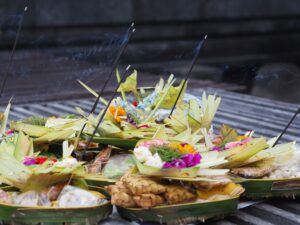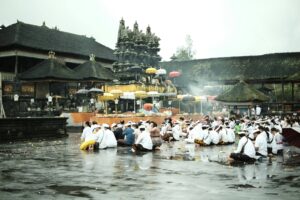Wanting to connect with Balinese culture responsibly is a wonderful aspiration for any visitor to the Island of the Gods. It promises a journey that goes deeper than picture-perfect landscapes, leading to a richer, more authentic, and truly memorable travel experience. While Bali’s stunning beaches and famous landmarks are undeniably captivating, the true heart of the island often reveals itself in quieter moments of genuine human connection and cultural understanding.
Many travelers today seek more than just sightseeing; they long to engage with the places they visit on a more meaningful level. This desire to connect respectfully not only enriches your own adventure but also honors the local community and their vibrant heritage.
As your friendly hosts here at Merusaka Nusa Dua, we believe that such connections are what transform a great holiday into an unforgettable one. So, we’re delighted to share five simple yet impactful ways you can step “beyond the tourist trail” and foster genuine, respectful engagement with the incredible culture of Bali.
Why Seek Meaningful Cultural Connections? The Rewards of Responsible Travel
Before we explore the “how,” let’s touch upon the “why.” Choosing to connect with Balinese culture responsibly offers so much. Therefore, you will find many wonderful benefits:
- Deeper Understanding & Appreciation: You gain insights into the values, beliefs, and daily life that shape this unique island, moving beyond surface impressions. This leads to a much richer experience.
- Mutual Respect: Making an effort to understand and respect local customs fosters positive interactions and goodwill between visitors and the host community. Furthermore, it truly makes a difference.
- More Memorable Experiences: Often, the most cherished travel memories come from these authentic encounters and genuine connections, not just from ticking off a list of sights. Indeed, these moments last a lifetime.
- Supporting Local Heritage: Your mindful engagement can contribute to the preservation and appreciation of Bali’s rich cultural traditions. Consequently, you help keep their beautiful heritage alive.
- Aligning with Balinese Philosophy: Such respectful interaction resonates deeply with the core Balinese philosophy of Tri Hita Karana – maintaining harmony with God, fellow humans, and nature. In other words, you become part of their beautiful philosophy.
Five Ways to Connect with Balinese Culture Responsibly
Here are some thoughtful approaches to experiencing Bali more deeply. These ideas will help you connect with Balinese culture responsibly during your visit.
1. Embrace the Language: Learn Basic Bahasa Indonesia & Local Greetings
The Impact of Effort: While many Balinese in tourist areas speak some English, making an effort to use even a few basic phrases in Bahasa Indonesia (the national language) or local Balinese greetings is a wonderful sign of respect and is almost always met with a warm smile. It shows you’re interested in their culture. Simply trying to speak a few words can open doors to heartwarming interactions and help you truly connect with Balinese culture responsibly.
Key Phrases to Start With:
- Selamat Pagi (Good Morning – until ~11 am)
- Selamat Siang (Good Day – ~11 am to ~3 pm)
- Selamat Sore (Good Afternoon/Late Afternoon – ~3 pm to sunset)
- Selamat Malam (Good Evening/Night)
- Terima Kasih (Thank you) – This is golden!
- Sama-sama (You’re welcome / Same to you)
- Permisi (Excuse me / May I pass?)
- Apa Kabar? (How are you?) – Responded with Baik-baik saja (Fine/Good).
Polite Address: Remember, using “Pak” (for men, like Mr.) or “Ibu” (for women, like Mrs./Ms.) before a name or when addressing someone you don’t know is a lovely gesture of politeness. This simple act can significantly help you connect with Balinese culture responsibly and show your respect.
2. Observe Daily Rituals & Ceremonies with Reverence
Bali’s spiritual life is vibrant and visible everywhere. Witnessing these moments can be incredibly moving. To truly connect with Balinese culture responsibly, understanding and respecting these daily practices is key.
Daily Offerings (Canang Sari): You’ll see these beautiful, small palm-leaf offerings everywhere. Understand their purpose as daily expressions of gratitude. The most important thing is to never step on or over them when they are placed on the ground. Always walk around. These offerings are a beautiful part of daily life and show the spiritual heart of Bali.
Temple Ceremonies (Odalan) & Processions: Odalan (temple anniversary festivals) and other ceremonies (like those during Galungan and Kuningan) are frequent. If you encounter one, it’s a wonderful opportunity to observe.
- Dress Modestly: Even if just passing by, ensure your shoulders and knees are covered. If you wish to enter a temple that is open to visitors during a ceremony (from the outer courtyards), a sarong and sash are essential. This shows genuine respect.
- Observe from a Respectful Distance: Don’t intrude into the main ritual areas unless specifically invited by a community member. Find a spot where you can see without disrupting. This is vital to connect with Balinese culture responsibly.
- Be Quiet & Still: Avoid loud conversations and unnecessary movement. Remember, these are sacred moments for the Balinese people.
- Photography with Permission & Discretion: Never use a flash. Ask politely before taking close-up photos of people, especially those in prayer. A respectful “Permisi, boleh foto?” (Excuse me, may I take a picture?) can go a long way.
- It’s Not a Show: Remember, these are sacred religious events for the community. Your respectful, quiet presence is usually welcome, and it helps you truly connect with Balinese culture responsibly.
3. Support Local Artisans & Community Businesses Ethically
Your spending can directly benefit local communities and help preserve traditional crafts. This is a powerful way to connect with Balinese culture responsibly and make a positive impact.
Buy Directly & Fairly: When shopping for handicrafts (wood carvings, silver, textiles, paintings), try to buy directly from artisans in their workshops (e.g., in craft villages near Ubud) or from reputable local shops that support them fairly. This is much better than solely from large tourist emporiums where the connection to the maker might be less clear. Our shopping guide has more tips.
Dine at Local Warungs: Eating at small, family-run eateries (warungs) is a fantastic way to taste authentic Balinese and Indonesian food and directly support local families. The food is delicious, and the experience is often very local and friendly.
Choose Community-Based Tourism (Thoughtfully): Look for tours or experiences that are genuinely community-owned or directly benefit local villages. This might include guided village walks (with a local guide!), or visiting initiatives focused on preserving local culture or environment. Do a little research to ensure they are truly ethical and respectful, allowing you to genuinely connect with Balinese culture responsibly.
4. Immerse Yourself: Participate in a Cultural Workshop or Class
One of the best ways to connect is through hands-on learning! Bali offers many wonderful workshops where you can truly connect with Balinese culture responsibly.
Balinese Cooking Class: Learn to prepare delicious local dishes, often starting with a market visit to select fresh ingredients. This is a delicious way to understand local life.
Offering Making (Banten): Join a class to learn the beautiful art of crafting Canang Sari or other more complex offerings. It gives a deep appreciation for the skill and devotion involved. You’ll gain new insights into the daily spiritual practices.
Gamelan or Balinese Dance Lesson: Try your hand (or feet!) at the basics of Bali’s mesmerizing music or graceful dances. Even a short introductory lesson is fun and insightful, and you’ll find a deeper appreciation for their art forms.
Batik Making or Lontar Weaving: Engage with traditional craft techniques and create your own piece of Balinese art. These workshops provide direct interaction with local experts and a tangible connection to the culture. You’ll not only learn a new skill but also truly connect with Balinese culture responsibly through creation.
5. Visit a Traditional Village or Community Setting (Respectfully, with a Guide)
Exploring beyond the main tourist centers can offer valuable insights. However, it’s crucial to do so with utmost respect and sensitivity. This approach allows you to truly connect with Balinese culture responsibly.
The Value of a Local Guide: Visiting a traditional village is often best done with a knowledgeable local guide who understands the community’s protocols, can facilitate respectful interaction, and share insights into daily life, the Banjar (community council) system, traditional architecture, and local customs. This avoids inadvertently causing offense or being intrusive, ensuring a positive experience for everyone.
Focus on Learning & Observing: The aim should be to learn and appreciate, not just to “see” people. Be an observer, not an intruder. Your presence should be gentle and respectful, allowing you to genuinely connect with Balinese culture responsibly in a sensitive way.
Ask Before Photographing People: This is always important, but especially in more private village settings. A smile and a polite gesture towards your camera usually suffice. Respect their answer if they decline.
Support, Don’t Intrude: Avoid treating villages like “human zoos.” If opportunities arise to support the community (e.g., buying local crafts, making a small donation to a community project via your guide if appropriate), do so thoughtfully.
The Spirit of Connection: A Two-Way Street
Meaningful cultural connection is always a two-way exchange. When visitors approach Bali with genuine curiosity, humility, an open heart, and a willingness to respect local customs, this is almost always met with incredible warmth, generosity, and openness from the Balinese people. Therefore, your efforts to understand and engage responsibly will not only enrich your travel experience profoundly but also contribute to fostering positive, sustainable tourism that benefits everyone. This truly helps you connect with Balinese culture responsibly and meaningfully.
Conclusion: Travel Deeper, Connect More
Bali offers so much more than just beautiful scenery. Its vibrant, living culture is there to be discovered by those who seek to connect with Balinese culture responsibly and respectfully. By embracing simple gestures like learning a few local phrases, observing rituals with reverence, supporting local communities ethically, and engaging in hands-on cultural learning, you can move “beyond the tourist trail” and create truly meaningful memories.
This kind of travel doesn’t just change where you’ve been; it can change how you see the world. We hope these suggestions inspire you to explore the deeper heart of Bali. Our team at Merusaka Nusa Dua is always happy to offer further advice or help you connect with respectful cultural experiences during your stay.






